Knowledge Patterns for the Web: extraction, transformation, and reuse
- 1. STLab Università di Bologna ! Knowledge Patterns for the Web: extraction, transformation, and reuse ! ! Ph.D. candidate Andrea Giovanni Nuzzolese [email protected] ! ! ! ! 19 May 2014 - Bologna Supervisor Paolo Ciancarini ! Tutors Aldo Gangemi Valentina Presutti
- 2. STLab Università di Bologna • Problem statement • Knowledge Patterns (KPs) • Methods and case studies of KP extraction from the Web • K~ore: a software architecture for experimenting with KPs • Aemoo: a KP-aware application for entity summarization and exploratory search on the Web • Conclusion Outline 2
- 3. STLab Università di Bologna 3 Problem statement
- 4. STLab Università di Bologna 4 The Linked Data cloud • The Web is evolving from a global information space of linked documents to one where both documents and data are linked, known as Linked Data
- 5. STLab Università di Bologna 5 The knowledge soup and the boundary problem • What is the information in the Web that provides the relevant knowledge about Barack Obama as a Nobel Prize laureate? • Interoperability problem: the Web is a knowledge soup because of the heterogeneity of formats, representation schemata and languages • Relevance problem: It is hard to draw meaningful boundaries around data in order to extract relevant contextual knowledge
- 6. STLab Università di Bologna 6 What do we need? • We need structures that organize entities (e.g., Barack Obama) and concepts (e.g., Nobel Prize laureate) according to a unifying view ! • We need methods for extracting these structures from the Web
- 7. STLab Università di Bologna 7 Knowledge Patterns
- 8. STLab Università di Bologna • Frames “…any system of concepts related in such a way that to understand any one of them you have to understand the whole structure in which it fits; when one of the things in such a structure is introduced into a text, or into a conversation, all of the others are automatically made available…” [Fillmore 1968] “…a remembered framework to be adapted to the reality by changing details as necessary. A frame is a data-structure for representing a stereotyped situation, like being in a certain kind of living room, or going to a child’s birthday party…” [Minsky 1975] ! • Semantic Web “…a KP is a formal schema for organizing concepts and relations that are relevant in a specific context…” [Gangemi and Presutti 2010] 8 KPs across disciplines
- 9. STLab Università di Bologna 9 A KP for OfficeHolder
- 10. STLab Università di Bologna 9 A KP for OfficeHolder Formal represenation
- 11. STLab Università di Bologna 9 A KP for OfficeHolder Access to data
- 12. STLab Università di Bologna 9 A KP for OfficeHolder Textual grounding From wikipedia.org
- 13. STLab Università di Bologna • To identify methods for the extraction of KPs from the Web ! ! ! ! ! • To design a software architecture for KP extraction • To evaluate the effectiveness of KPs in a knowledge interaction task, e.g., entity summarization and exploratory search 10 My thesis objectives
- 14. STLab Università di Bologna 11 Knowledge Pattern transformation
- 15. STLab Università di Bologna • To increase syntactic and semantic interoperability, hence to decrease the soup problem • By homogenizing existing KP-like artefacts expressed in heterogeneous formats, representing them as OWL 2 KPs 12 Motivations
- 16. STLab Università di Bologna • To increase syntactic and semantic interoperability, hence to decrease the soup problem • By homogenizing existing KP-like artefacts expressed in heterogeneous formats, representing them as OWL 2 KPs 12 Motivations FrameNet• Examples are
- 17. STLab Università di Bologna ontologydesignpatterns.org • To increase syntactic and semantic interoperability, hence to decrease the soup problem • By homogenizing existing KP-like artefacts expressed in heterogeneous formats, representing them as OWL 2 KPs 12 Motivations • Examples are
- 18. STLab Università di Bologna The Component Library • To increase syntactic and semantic interoperability, hence to decrease the soup problem • By homogenizing existing KP-like artefacts expressed in heterogeneous formats, representing them as OWL 2 KPs 12 Motivations • Examples are
- 19. STLab Università di Bologna 13 The KP transformation method: Semion
- 20. STLab Università di Bologna 14 KPs from FrameNet Syntactic reengineering
- 21. STLab Università di Bologna 14 KPs from FrameNet ABox refactoring
- 22. STLab Università di Bologna 14 KPs from FrameNet TBox refactoring
- 23. STLab Università di Bologna • A lexical dataset in Linked Data • Provides frames as RDF • Accessible via SPARQL endpoint • A set of 1024 KPs • Conceptually equivalent to FrameNet frames, but with explicit formal semantics • Published on ontologydesignpatterns.org • Evaluation • Based on the demonstration of the isomorphism of each transformation step 15 Results
- 24. STLab Università di Bologna 16 Knowledge Pattern extraction from data
- 25. STLab Università di Bologna 17 KP extraction: intuition
- 26. STLab Università di Bologna 17 KP extraction: intuition
- 27. STLab Università di Bologna ! • Motivation • To address the knowledge boundary problem ! • Hypothesis • The linking structure of Linked Data resources conveys a rich knowledge that can be used for KP extraction • Patterns observed over Linked Data links can be used for drawing meaningful boundaries around data 18 Motivation and hypothesis
- 28. STLab Università di Bologna 19 Method: key concepts 1. Collect RDF links 2. Index links 3. Collect statistics on indexed links 4. Induce boundaries around data 5. Formalize the KP
- 29. STLab Università di Bologna dbpedia:War_in_Afghanistan 20 Indexing RDF links: the Type Paths rdf:property A Type Path Pi,k,j is a property path, whose occurrences have the same rdf:type for their subject nodes and the same rdf:type for their object nodes dbpedia:Washington dbpedia:Barack_Obama
- 30. STLab Università di Bologna dbpedia:War_in_Afghanistan 20 Indexing RDF links: the Type Paths rdf:type rdf:property A Type Path Pi,k,j is a property path, whose occurrences have the same rdf:type for their subject nodes and the same rdf:type for their object nodes dbpedia:Washington dbpedia:Barack_Obama owl:Thing dbpo:Event dbpo:MilitaryConflict owl:Thing dbpo:Person dbpo:OfficeHolder dbpo:Country dbpo:Place owl:Thing
- 31. STLab Università di Bologna dbpedia:War_in_Afghanistan 20 Indexing RDF links: the Type Paths rdf:type rdf:property rdfs:subClassOf A Type Path Pi,k,j is a property path, whose occurrences have the same rdf:type for their subject nodes and the same rdf:type for their object nodes dbpedia:Washington dbpedia:Barack_Obama owl:Thing dbpo:Event dbpo:MilitaryConflict owl:Thing dbpo:Person dbpo:OfficeHolder dbpo:Country dbpo:Place owl:Thing
- 32. STLab Università di Bologna dbpedia:War_in_Afghanistan 20 Indexing RDF links: the Type Paths rdf:type rdf:property rdfs:subClassOf A Type Path Pi,k,j is a property path, whose occurrences have the same rdf:type for their subject nodes and the same rdf:type for their object nodes dbpedia:Washington dbpedia:Barack_Obama dbpo:MilitaryConflict dbpo:OfficeHolder dbpo:Country
- 33. STLab Università di Bologna 20 Indexing RDF links: the Type Paths rdf:property Type Path Type Path A Type Path Pi,k,j is a property path, whose occurrences have the same rdf:type for their subject nodes and the same rdf:type for their object nodes dbpo:MilitaryConflict dbpo:OfficeHolder dbpo:Country dbpo:OfficeHolder rdf:property
- 34. STLab Università di Bologna • A KP is a set of type paths, such that Pi,k,j ∈ KP ⟺ pathPopularity(Pi,k,j) ≥ t • t is a threshold, under which a type path is not included in an KP ! • The pathPopularity is the ratio of how many distinct resources of a certain type participate as subject in a path to the total number of resources of that type. E.g.: • POfficeHolder,wikiPageWikiLink,MilitaryConflict counts of 2500 occurrences in DBpedia • 20555 individuals belongs to OfficeHolder in DBpedia • pathPopularity(POfficeHolder,wikiPageWikiLink,MilitaryConflict) = 0.12 ! 21 Boundaries of KPs
- 35. STLab Università di Bologna • Wikipedia contains a lot of knowledge • It is a collaboratively edited, multilingual, free Internet encyclopaedia • It is a peculiar source for KP extraction • It has an RDF dump in Linked Data, i.e., DBpedia, grounded in a large corpus • The following design constraints that make KP investigation easier • Each wiki page describes a single topic, which corresponds to a single resource in DBpedia; • Wikilinks relate wiki pages. Hence each wikilink links two DBpedia resources, which are typed with DBPO classes 22 Case study: extracting KPs from Wikipedia links
- 36. STLab Università di Bologna 23 Boundary induction 1. For each path, calculate the pathPopularity 2. Apply multiple correlation between the paths of all subject types by rank, and check for homogeneity of ranks across subject types (Pearson ρ = 0.906) 3. Create a prototypical distribution of the pathPopularity for all the subject types 4. Decide the threshold t by applying clustering on the prototypical distribution of the pathPopularity
- 37. STLab Università di Bologna 23 Boundary induction 1. For each path, calculate the pathPopularity 2. Apply multiple correlation between the paths of all subject types by rank, and check for homogeneity of ranks across subject types (Pearson ρ = 0.906) 3. Create a prototypical distribution of the pathPopularity for all the subject types 4. Decide the threshold t by applying clustering on the prototypical distribution of the pathPopularity k-means (4 clusters): • 3 small clusters with ranks above 27,67% • 1 big cluster with ranks below 18,18%
- 38. STLab Università di Bologna 23 Boundary induction 1. For each path, calculate the pathPopularity 2. Apply multiple correlation between the paths of all subject types by rank, and check for homogeneity of ranks across subject types (Pearson ρ = 0.906) 3. Create a prototypical distribution of the pathPopularity for all the subject types 4. Decide the threshold t by applying clustering on the prototypical distribution of the pathPopularity k-means (6 clusters): • 1 big cluster with ranks below 11,89% • the 9th rank of pathPopularity is at 11,89% and 9 is the average number of frame elements in FrameNet
- 39. STLab Università di Bologna • Results • Discovered 184 KPs formalized as OWL 2 ontologies • KPs from Wikipedia links are called Encyclopaedic KPs (EKPs) as they capture encyclopaedic knowledge 24 Results and evaluation
- 40. STLab Università di Bologna • Results • Discovered 184 KPs formalized as OWL 2 ontologies • KPs from Wikipedia links are called Encyclopaedic KPs (EKPs) as they capture encyclopaedic knowledge 24 Results and evaluation • Evaluation • We conducted a user study asking 17 users to judge how relevant were a number of (object) types (i.e., paths) for describing things of a certain (subject) type, for a sample of 12 DBPO classes • We compared average multiple correlation (Spearman’s ⍴ ~0.75 on a range [-1, 1]) between users' assigned scores (Kendall’s W among users ~0.68 on a range [0, 1]), and pathPopularity based scores.
- 41. STLab Università di Bologna 25 Source enrichment
- 42. STLab Università di Bologna • Motivations • Most of the Web links are untyped and unlabelled hyperlinks • In many cases RDF statements do not provide typed entities (e.g., 33% of DBpedia entities are untyped) • The Web knowledge is mainly expressed by means of natural language • Hypothesis • Natural language text can be used for generating RDF data suitable for KP extraction • E.g., a text surrounding anchors in Web pages or annotations in RDF graphs 26 Motivations and hypothesis
- 43. STLab Università di Bologna • Using natural language definitions available in DBpedia abstracts in order to type DBpedia entities 27 Automatic typing of DBpedia entities
- 44. STLab Università di Bologna 27 Automatic typing of DBpedia entities Natural language deep parsing (FRED - http://wit.istc.cnr.it/stlab-tools/fred)
- 45. STLab Università di Bologna 27 Automatic typing of DBpedia entities Graph-based pattern matching
- 46. STLab Università di Bologna 27 Automatic typing of DBpedia entities Word-sense disambiguation
- 47. STLab Università di Bologna 27 Automatic typing of DBpedia entities Ontology Alignment
- 48. STLab Università di Bologna 28 Results • ORA: the Natural Ontology of Wikipedia • Typed 3,023,890 entities with associated taxonomies of types • Evaluation against a golden standard of the accuracy of types assigned to a sample set of 318 Wikipedia entities • User study for evaluating the soundness of the induced taxonomy of types for each DBpedia entity • Kendall’s W: 0.79
- 49. STLab Università di Bologna 29 Source enrichment: general approach
- 50. STLab Università di Bologna 29 Source enrichment: general approach • Based on this approach other applications have been developed so far • CiTalO: automatic identification of the nature of citations with respect to the CiTO ontology [Di Iorio et al.] • Sentilo: a semantic sentiment analysis tool [Reforgiato et al.] • Legalo: automatic uncovering of the semantics of hyperlinks
- 51. STLab Università di Bologna 30 K~ore
- 52. STLab Università di Bologna 31 Architecture
- 53. STLab Università di Bologna 31 Architecture Transformation (knowledge soup problem) Extraction (knowledge boundary problem) Reuse
- 54. STLab Università di Bologna 32 K~tools
- 55. STLab Università di Bologna 32 K~tools
- 56. STLab Università di Bologna 32 K~tools
- 57. STLab Università di Bologna 32 K~tools
- 58. STLab Università di Bologna 32 K~tools
- 59. STLab Università di Bologna 33 Aemoo
- 60. STLab Università di Bologna • Aemoo is a KP-aware application • A KP-aware application is a system which • Benefits from KPs for addressing knowledge interaction tasks • Uses KPs as the basic unit of mean for representing, exchanging, as well as reasoning with knolwedge • Aemoo exploits EKPs for • Entity summarisation and Exploratory search • Distinguishing between core and peculiar knowledge • The data sources are Wikipedia, DBpedia,Twitter, and GoogleNews 34 Aemoo in a nutshell
- 61. STLab Università di Bologna 35 Aemoo UI http://aemoo.org
- 62. STLab Università di Bologna • We asked to 83 users to use Aemoo, RelFinder and Google for tasks of • Summarization • Lookup • Exploratory search 36 Evaluation
- 63. STLab Università di Bologna 37 Conclusion • We have provided methodologies for • KP transformation • KP extraction • Source enrichment • We have designed a software architecture which implements such methodologies • We have developed a KP-aware application:Aemoo • We are contributing to the realization of the Semantic Web as an empirical science • We have generated KPs and published them into a repository for reuse
- 64. STLab Università di Bologna • 16 peer reviewed articles in international conferences and workshops • V. Presutti, D. Reforgiato A. Gangemi,A. Nuzzolese, S. Consoli. Sentilo: Frame-based Sentiment Analysis. Cognitive Computation, to appear. • Paolo Ciancarini,Angelo Di Iorio,Andrea Giovanni Nuzzolese, Silvio Peroni, FabioVitali: Evaluating Citation Functions in CiTO: Cognitive Issues. In Proceedings of the 11th Extended Semantic Web conference (ESWC 2014). Springer, pp 580-594, Heraklion, Greece, 2014 • A. G. Nuzzolese,V. Presutti,A. Gangemi,A. Musetti, P. Ciancarini.Aemoo: exploring knowledge on the web , In: Proceedings of the 5th Annual ACM Web Science Conference .ACM, pp. 272-275, Paris, France, 2013. • A. Gangemi,A. G. Nuzzolese,V. Presutti, F. Draicchio,A. Musetti, P. Ciancarini.Automatic typing of DBpedia entities . In: J. Hein,A. Bernstein, P. Cudre-Mauroux, editors, Proceedings of the 11th International Semantic Web Conference (ISWC2012). Springer, pp. 65-91, Boston, Massachusetts, US, 2012. • A. G. Nuzzolese. Knowledge Pattern Extraction and their usage in Exploratory Search. In: J. Hein,A. Bernstein, P. Cudre-Mauroux, editors, Proceedings of the 11th International Semantic Web Conference (ISWC2012) . Springer, pp. 449-452, Boston, Massachusetts, US, 2012. • A. G. Nuzzolese,A. Gangemi,V. Presutti, P. Ciancarini. Encyclopedic Knowledge Patterns from Wikipedia Links . In: L. Aroyo, N. Noy, C.Welty, editors, Proceedings of the 10th International Semantic Web Conference (ISWC2011) . Springer, pp. 520-536, Bonn, Germany, 2011. • A. G. Nuzzolese,A. Gangemi, andV. Presutti. Gathering Lexical Linked Data and Knowledge Patterns from FrameNet . In M. Musen, O. Corcho, editors, Proceedings of the 6th International Conference on Knowledge Capture (K-CAP) , pp. 41-48.ACM,Alberta, Canada, 2011. 38 Publications
- 65. STLab Università di Bologna 39 Thank you
- 66. STLab Università di Bologna 40
- 67. STLab Università di Bologna • FrameNet is an XML lexical knowledge base • Cognitive soundness • Grounded in a large corpus • It consists of a set of frames, which have • Frame elements • Lexical units, which pair words (lexemes) to frames • Relations to corpus elements • Each frame can be interpreted as a class of situations 41 FrameNet
- 68. STLab Università di Bologna 42 Natural Language Enhancer
- 69. STLab Università di Bologna 43 Refactor
- 70. STLab Università di Bologna 44 Knowledge Pattern Extractor
- 71. STLab Università di Bologna 45 Boundary induction Step Description 1 For each path, calculate the path popularity 2 For each subject type, get the N top-ranked path popularity values 3 Apply multiple correlation (Pearson ρ) between the paths of all subject types by rank, and check for homogeneity of ranks across subject types 4 For each of the N path popularity ranks, calculate its mean across all subject types 5 Apply clustering (e.g., k-means) on the N ranks 6 Decide threshold(s) based on the clustering as well as other indicators (e.g., FrameNet roles distribution)
- 72. STLab Università di Bologna 46 Contextualized views • What is the information in the Web that provides the relevant knowledge about Barack Obama as a Nobel Prize laureate? From the Google Knowledge Graph From wikipedia.org
- 73. STLab Università di Bologna • Linked Data is a breakthrough in Semantic Web for the creation of the Web of Data • The Web of Data offers large datasets for empirical research • For the first time in the history of knowledge engineering we have datasets • Created by large communities of practice • With a lot of realistic data • On which experiments can be performed • The Semantic Web can be founded as an empirical science • In our vision KPs are the research objects of the Web as an empirical science 47 The Web of Data
- 74. STLab Università di Bologna • They are archetypal solutions to common and frequently occurring design problems • They were introduced in the seventies by the architect and mathematician Christopher Alexander. “a good architectural design can be achieved by means of a set of rules that are packaged in the form of patterns, such as “courtyards which live”, “windows place”, or “entrance room” [Alexander 1979] • They enable design based on reuse • Software Engineering has eagerly borrowed design patterns “. . . designers […] look for patterns to match against plans, algorithms, data structures, and idioms they have learned in the past. . .” [Gamma et al. 1993] 48 Design Patterns
- 75. STLab Università di Bologna • Ontologies are artefacts that encode a description of some world • Like any artefact, they have a lifecycle: they are designed, implemented, evaluated, fixed, exploited, reused, etc. • An Ontology Design Pattern (ODP) [Gangemi and Presutti 2009] is a modeling solution to solve a recurrent ontology design problem • Reusability in Ontology Engineering 49 Ontology Design Patterns
- 76. STLab Università di Bologna • A Knowledge Pattern is a small, well connected and recurrent unit of meaning, which provides a semantic interpretation for a symbolic schema. It is • task based: a KP is associated to an explicit task typically expressed by means of competency questions • well-grounded: a KP enables access to big data • cognitively sound: a KP closely mirrors the human ways of organizing knowledge 50 A definition for KP








![STLab Università di Bologna
• Frames
“…any system of concepts related in such a way that to understand any one of them you have
to understand the whole structure in which it fits; when one of the things in such a structure is
introduced into a text, or into a conversation, all of the others are automatically made
available…” [Fillmore 1968]
“…a remembered framework to be adapted to the reality by changing details as necessary. A
frame is a data-structure for representing a stereotyped situation, like being in a certain kind of
living room, or going to a child’s birthday party…” [Minsky 1975]
!
• Semantic Web
“…a KP is a formal schema for organizing concepts and relations that are relevant in a specific
context…” [Gangemi and Presutti 2010]
8
KPs across disciplines](https://image.slidesharecdn.com/thesisfinal-140530052159-phpapp01/85/Knowledge-Patterns-for-the-Web-extraction-transformation-and-reuse-8-320.jpg)



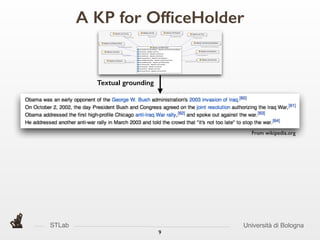












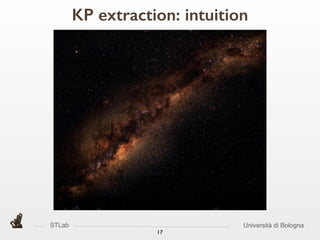

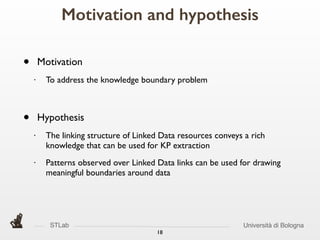


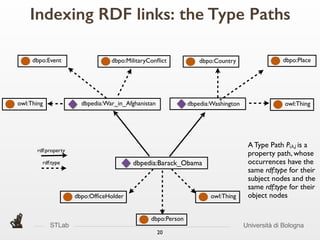





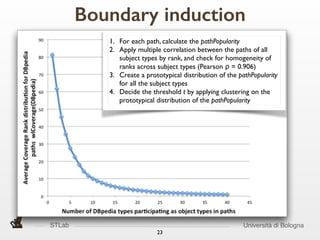



![STLab Università di Bologna
• Results
• Discovered 184 KPs formalized as OWL 2 ontologies
• KPs from Wikipedia links are called Encyclopaedic KPs (EKPs) as
they capture encyclopaedic knowledge
24
Results and evaluation
• Evaluation
• We conducted a user study asking 17 users to judge how relevant were
a number of (object) types (i.e., paths) for describing things of a certain
(subject) type, for a sample of 12 DBPO classes
• We compared average multiple correlation (Spearman’s ⍴ ~0.75 on a
range [-1, 1]) between users' assigned scores (Kendall’s W among
users ~0.68 on a range [0, 1]), and pathPopularity based scores.](https://image.slidesharecdn.com/thesisfinal-140530052159-phpapp01/85/Knowledge-Patterns-for-the-Web-extraction-transformation-and-reuse-40-320.jpg)


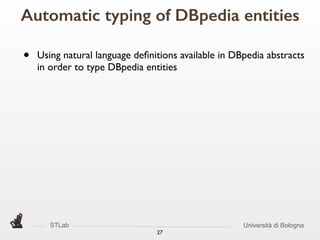






![STLab Università di Bologna
29
Source enrichment: general approach
• Based on this approach other applications have been developed
so far
• CiTalO: automatic identification of the nature of citations with
respect to the CiTO ontology [Di Iorio et al.]
• Sentilo: a semantic sentiment analysis tool [Reforgiato et al.]
• Legalo: automatic uncovering of the semantics of hyperlinks](https://image.slidesharecdn.com/thesisfinal-140530052159-phpapp01/85/Knowledge-Patterns-for-the-Web-extraction-transformation-and-reuse-50-320.jpg)

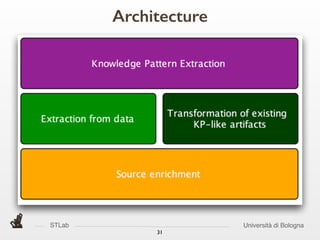


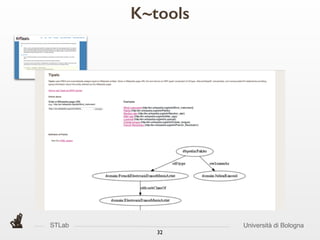


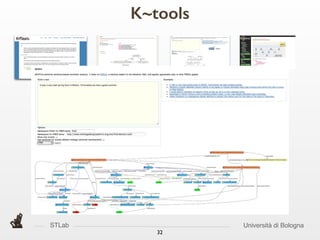






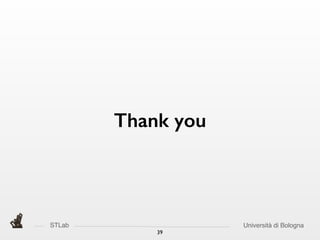








![STLab Università di Bologna
• They are archetypal solutions to common and frequently
occurring design problems
• They were introduced in the seventies by the architect and
mathematician Christopher Alexander.
“a good architectural design can be achieved by means of a set of rules that are packaged in
the form of patterns, such as “courtyards which live”, “windows place”, or “entrance
room” [Alexander 1979]
• They enable design based on reuse
• Software Engineering has eagerly borrowed design patterns
“. . . designers […] look for patterns to match against plans, algorithms, data structures,
and idioms they have learned in the past. . .” [Gamma et al. 1993]
48
Design Patterns](https://image.slidesharecdn.com/thesisfinal-140530052159-phpapp01/85/Knowledge-Patterns-for-the-Web-extraction-transformation-and-reuse-74-320.jpg)
![STLab Università di Bologna
• Ontologies are artefacts that encode a description of some
world
• Like any artefact, they have a lifecycle: they are designed, implemented,
evaluated, fixed, exploited, reused, etc.
• An Ontology Design Pattern (ODP) [Gangemi and Presutti
2009] is a modeling solution to solve a recurrent ontology
design problem
• Reusability in Ontology Engineering
49
Ontology Design Patterns](https://image.slidesharecdn.com/thesisfinal-140530052159-phpapp01/85/Knowledge-Patterns-for-the-Web-extraction-transformation-and-reuse-75-320.jpg)
